七年级英语教案
人教版初一英语上册教案15篇

人教版初一英语上册教案15篇人教版初一英语上册教案【篇1】教学年级:七年级课程名称:Unit 3 Why do you like koalas?教材版本:人民教育出版社授课时间:40分钟(一)学生分析:1.本班学生对学习英语较感兴趣,能积极参加各种调查、采访、表演等实践活动。
2.学生学习动机明确,学习态度积极主动,能主动与他人合作,相互帮助,共同完成学习任务,遇到问题敢于主动向老师和同学请教,能大胆用英语交流。
(二)教材分析:本课时的内容是义务教育课程标准实验教科书英语新目标“Go for it!”七年级的《Unit 3 Why do you like koalas?》第一课时,主要话题是学习动物名称,并讨论喜好某种动物的原因。
通过话题的讨论喜欢动物的原因,增强了动物名称的词汇量,还增强课堂学习趣味性。
(三)教学目标语言知识目标1.学习有关动物的名词:tiger elephant koala dolphin panda lion penguin giraffe2.学习并运用品质的.形容词:cute smart shy ugly clever beautiful friendly quiet lazy来描述动物.3.掌握下列句型Why do you like…?. Because they’re….使学生熟练表达喜好并陈述原因。
语言能力目标1.学生能熟练谈论自己喜爱的动物并给出理由。
2.学生的口语和书面表达能力得到提高。
3.培养学生主动参与语言实践活动的能力,在游戏和小组竞赛中培养学生乐于表达、勇于展示自我的能力,从而树立学习英语的信心,获取成功的喜悦。
情感目标1.通过学习要培养学生自觉保护动物的意识。
2.培养学生积极参与,发扬团队合作的精神和竞争意识。
(四)教学策略1、教学方法Task-based, Language Teaching,途径:Guesing game, group work, pair work, survey, Internet teaching.2、教学辅助手段采用多媒体电脑投影图片,充分利用网络教材资源,扩大学生的知识面,激发学生的兴趣和求知欲。
七年级英语优秀教学设计(通用8篇)

七年级英语优秀教学设计(通用8篇)七年级英语优秀教学设计(通用8篇)作为一位兢兢业业的人民教师,常常要写一份优秀的教学设计,教学设计是把教学原理转化为教学材料和教学活动的计划。
我们应该怎么写教学设计呢?以下是小编精心整理的七年级英语优秀教学设计,仅供参考,大家一起来看看吧。
七年级英语优秀教学设计篇1Unit3. Why do yu like koalas?The first periodⅠ.Teaching Aims and Demands1.Knowledge Objects.1)Key vocabularykoala tiger elephent.dolphin panda lion penguin giraffe zoo cute map smart2)Target languageLet’s see the pandas.Why do you like see the tigers?Because they are cute.2.Ability Objects:1)Train students’abilities of listening and speakng.2) Enable and help the students to learn how to listen to and talk about animals.3.Moral Object:It is very important for everyone to love the nature and protect animals .The earth is our home and animals are our friends..It is our duty to love the nature and protect enviroment.Ⅱ Teaching Key and Difficult Points1)Describe the animals using the words and the target language.2)Get students to learn “Why questions”, “Because answers” a nd the adjectives of quality.Ⅲ.Teaching methods1)Watching and describing methods2) Oral practicing method.Ⅳ.Teaching Aids:1)objects and some pictures.2)A recorder and computerⅤ.Teaching proceduresStep1.Warming up1) Play the tape,get the students to listen to music of animals2) Play a guessing game.T: Listening to the voices of animals.What kinds of animals are they?3) Show some pictures about animals after guessing and talk about animals.T: Look,there is a big zoo in our city There are many animals init.Do you want to see the animals in the zoo?Let’s go into thezoo.What kind of animals can you see?Step2.Present the new words1) T: Look. What is this in Chinese?Ss:“考拉”T: What is this in English?Do you know?Ss: NoT: It is a koala. Read after me K-O-A-L A, koala.2)Show some new words in the pictures.and teach students to learn them.:koala tiger elephent.dolphin panda lion penguin giraffezoo cute map smartStep3. Practice the new words(1a)1)Get students to read the words in 1a2)Match the words with the animals in the oictures.3)After that check the answers.Step4. Task1) Look at the pictures of animals and describe the animals like this. T: Let’s see the pandas .Do you like them?S1: Yes.I like them very much.T: Why do you like them?S1: Because they are cute .Let’s see the lions.T: Why do you want to see the lions.?S1: Because they are smart.T: Do they live on the land or in the water?S1: They live on the land.(At the same time,Teach the students the words,smart,cute)2)Get students to come up wth more new adjectives of quality to describe the animals.cute, smart, fun, interesting, scary, shy, lazy.(At this time,we can also let the students have a competition.This method can make the students active in class and it can help them develop their quick response and wide thinking)3)Get students to ask and answer in pairs to descibe the animals.4)Get students to performin in front of the class.Step5. Listening1)Play the tape,get students to listen and check.the animals in 12)Play the tape again.Ask students to work in pairs.Studentslisten and repeat after the recording3)Check the answer.Step6. Pairwork1)Ask the students to make conversations in pairs. Show the followng.A:Let’s see the elephant.B:Why do you want to see the elephant?A:Because they are very smart.(T:Now please make conversations in pairs ,using the animals in Activity 1c.You can have a competition and let’s see which pair of students is the best?)2)Get a few pairs to show their conversations.Step7 SummaryToday we have learnt lots of new words of animals,and the target language.We can describe the animals and other things using the target language.Now,We should remember the earth is our home and animals are our friends. It is our duty to protect animals and love the nature. Step8 Homework.1)Make a survey:What animals do you like?why?2)Write them down and make a conversationVI Blackboard design七年级英语优秀教学设计篇2一、教学目标:1. 语言知识目标:1) 能掌握以下单词:guitar, sing, swim, dance, chess, play chess, draw, speak, speak English, join, club能掌握以下句型:① —Can you play the guitar? —Yes, I can./ No, I can't.② —What can you do? —I can dance.③ —What club do you want to join? —I want to join the chess club.2) 能了解以下语法:情态动词can的用法want to do sth.的用法2. 情感态度价值观目标:该部分内容贴近学生的生活,谈论的话题是能力。
七年级英语备课教案

七年级英语备课教案七年级英语备课教案精选篇1:Listening播放听力材料,要求学生圈出所听到的单词,然后再次播放听力材料,要求学生根据听力内容回答问题。
引领学生捕捉关键信息,聚焦目标语言。
旨在帮助学生巩固家庭成员称谓这一目标语言,同时为下一步的目标句型的输出做铺垫。
七年级英语备课教案精选篇2一. 教学内容:Unit 5 Part 1初步学会陈述做某事的理由及目的二. 教学重点和难点:1. 用两个句型表达抱怨某事、某人的方法。
2. 修饰性副词的使用。
3. 要点解析。
三. 具体内容:(一)enough1. enough修饰形容词或副词时必须位于被修饰的词语之后。
修饰名词时一般位于其前,也可位于其后。
enough后面通常接不定式短语或介词for短语。
e.g. The question is easy enough.Tom didn’t do his homework carefully enough.The water is cool enough to drink.We have enough tickets for all of you.2. 修饰形容词时,如果用于否定句,则否定句在否定enough的同时,也否定了其后的不定式。
e.g He is not careful enough to do the work.She is not old enough to go to school.enough如果修饰名词,用于否定句时,不定式没有被否定之意。
e.g. There were not enough people to pick the apples.3. enough也可以做代词,意思是“足够,充足”。
e.g. We have enough to do to complete the project.(二)too…to…too+形容词或副词+(for sb.)+to do 表示“太……以至于不能……”,不定式虽然是肯定形式,但与前面的搭配构成了否定的含义。
英语教学教案七年级七篇

英语教学教案七年级七篇英语教学教案七年级【篇1】Unit 3How do yougetto school?Section AThe first period一教学目的:1.学习Section A 中的生词。
2.学习句型:How do yougetto school?3.词组:takethe traintake the bustake the subwayride a bike二、教学重点:同上三、教学难点:本课中生词的拼写。
四、教学过程:Step1Learn the new words.train ,take the train .bustake the bus .subway ,ridebikeride a bikeStep2IntroductionAsk the students like this:How do yougetto school?Then ask some students to answer thisquestion.Step3PracticeMatch the wordswith the pictures1.takethetrain(a)2.take the bus(3.take the subway(e)4.ride a bike(b)5walk(c)Step4ListenListen and write the numbers next to the correct students in the picture aboveStep 5PracticeMake a conversation with your partner about how the students get to schoolFor example :How does LiFei get to school?She takes the subway五、布置作业。
英语教学教案七年级【篇2】初一英语外研版(上)教案 Module 8 Choosing presents一、学习目标: 1.单词和短语:card, party, present, would, always, great, cake, never, special, eat, give, sing, happy, secret, CD, cinema, concert, magazine, scarf, silk, shirt, T-shirt, choose, exercise, wear, expensive, clothes, shoes, spend, money, film, song, match, weekend, at weekends, dear, hear, hear from, afraid2.交际用语:1)—Would you like to come to my birthday party? —Yes, I’d like to.When is it? 2)Great! 3)It’s a secret.3.重点句子:1) Daming always gets birthday presents! 2) She often goes to the cinema.3) What do you usually do at a Chinese birthday party? 4) We sometimes give birthday cards.5) My mother never makes a birthday cake.二、重点及难点:1.频度副词的使用及在句中的位置。
七年级上册英语教案人教版免费

七年级上册英语教案人教版免费(经典版)编制人:__________________审核人:__________________审批人:__________________编制单位:__________________编制时间:____年____月____日序言下载提示:该文档是本店铺精心编制而成的,希望大家下载后,能够帮助大家解决实际问题。
文档下载后可定制修改,请根据实际需要进行调整和使用,谢谢!并且,本店铺为大家提供各种类型的经典范文,如工作总结、述职报告、策划方案、演讲致辞、合同协议、条据文书、教案资料、好词好句、作文大全、其他范文等等,想了解不同范文格式和写法,敬请关注!Download tips: This document is carefully compiled by this editor. I hope that after you download it, it can help you solve practical problems. The document can be customized and modified after downloading, please adjust and use it according to actual needs, thank you!Moreover, our store provides various types of classic sample essays for everyone, such as work summaries, job reports, planning plans, speeches, contract agreements, doctrinal documents, lesson plans, good words and sentences, complete essays, and other sample essays. If you want to learn about different sample formats and writing methods, please pay attention!七年级上册英语教案人教版免费最新七年级上册英语教案人教版免费(8篇)作为一位不辞辛劳的人·民教师,通常会被要求编写教案,那么关于七年级上册英语教案怎么写呢?以下是本店铺准备的一些七年级上册英语教案人教版免费,仅供参考。
英语七年级教案

英语七年级教案英语七年级教案4篇英语老师要注重以学生为主体、教师为导的教学方法,充分调动学生的学习积极性。
作为初一七年级英语老师,你有在课前准备初一七年级英语教案?它对你的工作有着许多帮助。
你是否在找正准备撰写“英语七年级教案”,下面作者收集了相关的素材,供大家写文参考!英语七年级教案篇1教学目标1. 语言知识目标:1) 能掌握以下单词: newspaper, use, soup, wash, movie, just能掌握以下句型:① —What are you doing? —I'm watching TV.② —What's he doing? —He's using the puter.③ —What are they doing? —They're listening to a CD.④ —This is Jenny. —It's Laura here.2) 能掌握语法:现在进行时态的用法。
3) 能运用所学的知识,描述人们正在干的事情。
教学重难点1. 教学重点:1) 词汇、词组搭配和现在进行时的用法。
能用现在进行时的各种形式进行准确的描述和表达正在发生的动作。
2) 能掌握现在进行时态及一些表示具体动作的词组搭配,如: doing homework, using the puter, watching TV, eating dinner… 等2. 教学难点:现在进行时中现在分词的结构及读音,能在交际中准确地运用现在进行时来描述或表达正在进行的动作。
教学工具多媒体教学过程Ⅰ. Warming-up and Lead in1. Greet the Ss and check the homework.2. Watch a video program.Ⅱ. Presentation1. Show some pictures on the big screen. Present the new words and expressions.2. Ss watch and learn the new words and expressions.3. Give Ss some time and try to remember the new words and expressions.4. (Show some pictures on the screen and ask some students to perform the actions.). T: What are you doing?S: I am doing homework. (Help him to answer)T: What is he doing?Ss: He is doing homework.Teach: watching TV, cleaning, reading a book, eating dinner, talking on the phone.. the same way.5. Work on 1a. Ss read the activities and look at the pictures. Then match the activities with pictures.6. Check the answers with the Ss.Ⅲ. Game (guess)1. T: Now let's play a game. What's she doing? You must watch the big screen carefully.(Show some pictures on the big screen quickly) Let Ss guess what's he is doing?2. Ss watch and guess the actions.3. Ask and answer about the pictures.—What's he doing?—He's's …Ⅳ. Listening1. T: What are Jenny, John, Dave and Mary doing? Now let’s listen to the tape, find out the right activities from 1a.2. Play the recording for the Ss twice.3. Ss listen to the recording and write the numbers from 1a.Ⅴ. Pair work1. Ask the Ss to read the conversations in 1c with a partner. Then look at the pictures in 1a. And conversations about other person in the picture.2. Ss make conversations by themselves and practice the conversations.Ⅵ. Listening1. Work on 2a;T: Jack and Steve are talking on the phone. What are they doing now? Listen to the conversations and match the answers with the questions. (Play the recording for the first time, students only listen carefully. Then, listen to the recording again, and match the answers with the questions. )Check the answers.2. Work on 2b.Let Ss read the conversation in 2b first. Then play the recording for the Ss twice.The first time Ss only listen and write down the words in the blanks. Then play the recording again for the Ss to check the answers. (If necessary, press the Pause button to help.)Ⅶ. Pair work1. Now, role-play the conversation with your partners.2. Let some pairs to act out the conversation in front of the class.Ⅷ. Role-play1. Ask Ss to read the conversation in 2d and answer the questions below.① Are Jenny and Laura talking on the phone?(Yes, they are.)② What's Laura doing now?(She's washing her clothes.)③ What's Jenny doing?(She's watching TV.)④ When do they meet at Jenny's home?(At half past six.)2. Ss read the conversation and answer the questions above.3. Check the answers with the Ss.4. Let Ss work in pairs and role-play the conversation.Homework:1. Review the words and expressions in this period.2. Understand the knowledge about the present progressive tense.3. Make five sentences on what are you doing now.英语七年级教案篇2Language Goal:Talk about what people are doing.Teaching Aims:The present Progressive (结构式: Be + V-ing )Key Points:#What’s he doing ?#He’s reading.Difficult points:现在进行时的用法和动词V-ing 形式的构成。
七年级英语教案(优秀8篇)

七年级英语教案(优秀8篇)初一英语教案篇一【课题】Unit1 My name’s Gina.【学习目标】知识与能力:1、掌握并规范字母Ii-Rr.2、识记本单元词汇:what, this, in, English, a, an, map, orange, jacket, key, quilt, pen, ruler, spell, please, etc.过程与方法:学会从对话中获取对方的相关信息。
情感态度与价值观:使学生学会如何礼貌的与他人交往。
【学习重难点】:熟练掌握本单元词汇及语言结构。
一、自主预习【预习任务】:任务一:写出下列汉语的英语形式。
名字xx遇见xx问题,难题xx 回答,答案xx第一的x 最后的xx任务二:写出下列单词的汉语意思。
1、my2、clock3、nice4、what5、your6、hello7、I8、you9、his10、her11、name12、are13、is【预习诊断】:1、选择题:(1)Kate has lost(丢失)_________key、_________asked _________for help、A、her ,he, IB、his, he ,meC、his, she, ID、her, she, me(2)_________plus(加)seven is thirteen?A、FiveB、SixC、EightD、Nine(3)_________is her name?A、whoB、what C where D、How2、写出下列英语形式。
(1):电话号码?_________(2):早晨好_________(3):下午好_________3、写出下列词的英语意思:1)、早晨_________2)、下午_________3)、晚上_________4)、谢谢_________5)、名字_________6)、好的_________or_________【预习反思】:你还有什么问题吗?(Do you have any problems?)二、课中实施Step1 交流展示Step2 精讲点拨:What’s your name?你叫什么名字?句中的your可根据问对象换成his、her等物主代词。
七年级英语备课教案4篇
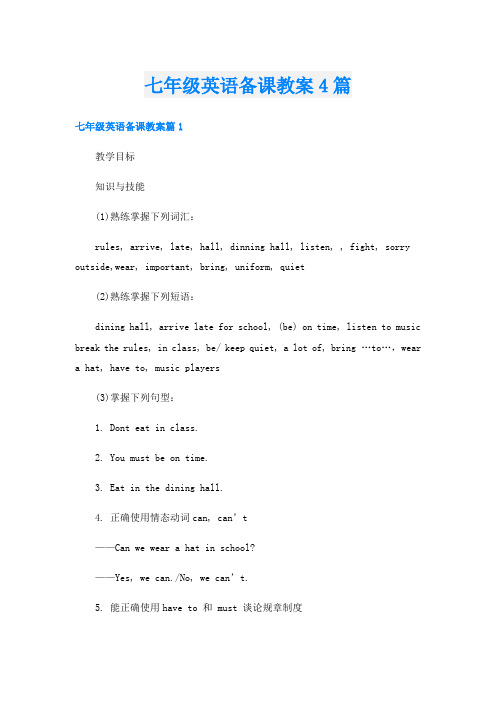
七年级英语备课教案4篇七年级英语备课教案篇1教学目标知识与技能(1)熟练掌握下列词汇:rules, arrive, late, hall, dinning hall, listen, , fight, sorry outside,wear, important, bring, uniform, quiet(2)熟练掌握下列短语:dining hall, arrive late for school, (be) on time, listen to music break the rules, in class, be/ keep quiet, a lot of, bring …to…,weara hat, have to, music players(3)掌握下列句型:1. Dont eat in class.2. You must be on time.3. Eat in the dining hall.4. 正确使用情态动词can, can’t——Can we wear a hat in school?——Yes, we can./No, we can’t.5. 能正确使用have to 和 must 谈论规章制度We must be on time/ We also have to be quiet in the library.教学重难点重点:1) 肯定祈使句是省略掉主语的原形动词开头;2) 否定祈使句则是在肯定祈使句前加上“don’t”。
3) 情态动词must及have to在用法上的区别。
难点:掌握祈使句的用法,并能听懂、会说一些简单的祈使句。
教学工具ppt教学过程一.新课预习1.小组合作学习本课单词,根据汉语写出下列英语单词。
规则_______ 到达_________ 准时___________走廊___________礼堂_________ 餐厅_______________倾听___________________听……______________打架_______________抱歉的_____________ 非常重要_____________ 带来;拿来_________________不得不_____________ 校服;制服_________________2.试着翻译下列句子。
初中七年级英语教案范文三篇
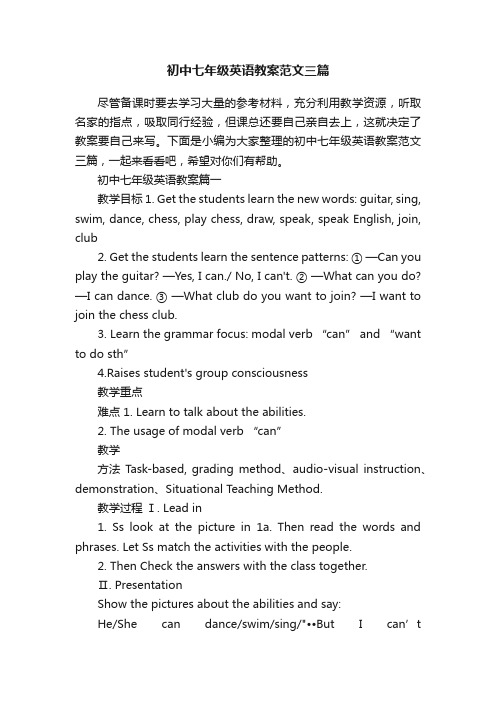
初中七年级英语教案范文三篇尽管备课时要去学习大量的参考材料,充分利用教学资源,听取名家的指点,吸取同行经验,但课总还要自己亲自去上,这就决定了教案要自己来写。
下面是小编为大家整理的初中七年级英语教案范文三篇,一起来看看吧,希望对你们有帮助。
初中七年级英语教案篇一教学目标 1. Get the students learn the new words: guitar, sing, swim, dance, chess, play chess, draw, speak, speak English, join, club2. Get the students learn the sentence patterns: ① —Can you play the guitar? —Yes, I can./ No, I can't. ② —What can you do? —I ca n dance. ③ —What club do you want to join? —I want to join the chess club.3. Learn the grammar focus: modal verb “can” and “want to do sth”4.Raises student's group consciousness教学重点难点 1. Learn to talk about the abilities.2. The usage of modal verb “can”教学方法Task-based, grading method、audio-visual instruction、demonstration、Situational Teaching Method.教学过程Ⅰ. Lead in1. Ss look at the picture in 1a. Then read the words and phrases. Let Ss match the activities with the people.2. Then Check the answers with the class together.Ⅱ. PresentationShow the pictures about the abilities and say:He/She can dance/swim/sing/"••But I can’tdance/swim/sing/...Ⅲ. Game (What can I do?)T: Tell your partners what you can do. For example:I can play the guitar. I can sing and dance.Ss work in groups. The let some Ss talk to their classmates in front of the class.Ⅳ. Listening1. T: Now let’s listen to the tape, find out the right conversation, and number them 1-3.2. Check the answers: (3, 2, 1 )Ⅴ. Pair work1. Ask the Ss to practice the conversations in 1b with a partner. Then make their own conversations. Ⅵ. Listening1. Work on 2a;T: Now, look at the pictures on P2, listen to the four conversations. Just listen.(Play the recording for the first time, students only listen carefully.)Then, listen to the recording again, and circle the clubs you hear.Check the answers with the class.2. Work on 2b;3. Check the answers with the Ss.Ⅶ. Pair work1. Look at 2b and talk about what the people can do and the clubs they want to join.T: What club does Lisa want to join?S1: She wants to join the chess club.T: Can she play chess?S1: No, she can't.2. Ss work in pairs to practice asking and answer about Lisa, Bob and Mary.3. Ask some pairs to act out their conversations.Ⅷ.Homework:1. Remember the new words and expressions after class.2. Recite the conversation after class.3. Write English names as many as possible in the exercises book.Ⅸ.Blackboard design Section A 1 (1a-2d)Drills:1. —Can you sing? —Yes, I can./No, I can't.2. 2b: 1. chess, chess 2. English; English3. sing, dance, music4. ① What club does Bob join?② What club does Jane join?5. want to do sthThey want to have some rice and vegetables.初中七年级英语教案篇二第一单元备课教案一、语言知识与技能1.根据读音规则和音标拼读单词。
七年级英语教案

七年级英语教案•相关推荐七年级英语教案(通用5篇)在教学工作者实际的教学活动中,往往需要进行教案编写工作,借助教案可以更好地组织教学活动。
如何把教案做到重点突出呢?下面是小编整理的七年级英语教案,供大家参考借鉴,希望可以帮助到有需要的朋友。
七年级英语教案篇1【学习目标】:1、熟练掌握本课13个单词.2、谈论对方喜欢或不喜欢的食物。
【学习重点】:名词的复数形式。
【学习过程】:一、自主学习(教师寄语:knowledge is power.)学习任务一: 会读写本课13个单词.1.个人自读,记忆本课单词.2.小组互相检查单词读写情况.3.根据汉语写出下列英语单词并展示喜欢___________香蕉_____________汉堡包___________西红柿_________花椰菜_________薯条_____________橙子_____________冰____________奶油__________ 冰淇淋_________ 沙拉___________ 草莓_________梨__________学习任务二: 谈论对方喜欢或不喜欢的食物。
1. 录音完成1b (面的对话编号)2. 两人一组练习1b 对话.3. pair work 和你同伴模仿1b对话.编新对话.二、合作共建(教师寄语:many hands make light work. )小组讨论你所学的不可数名词._______________________________________________________三、系统总结(教师寄语:no man can do two things at once.)i. 一般情况下加-s . 如: book bookshamburger _____________pear__________ banana_______________ orange_________ ii. 以 o 结尾的加-s 或-es 如: photo photos tomato _______________iii. 以 s . sh ch . x 结尾的加-es 如: watch watchesbus _________iv . 以辅音字母加y 结尾的变y 为i 加es . 如:dictionary dictionariesstrawberry __________ family _______________四、诊断评价:(一)翻译下列句子.1.我喜欢花椰菜。
人教版七年级英语优秀教案五篇
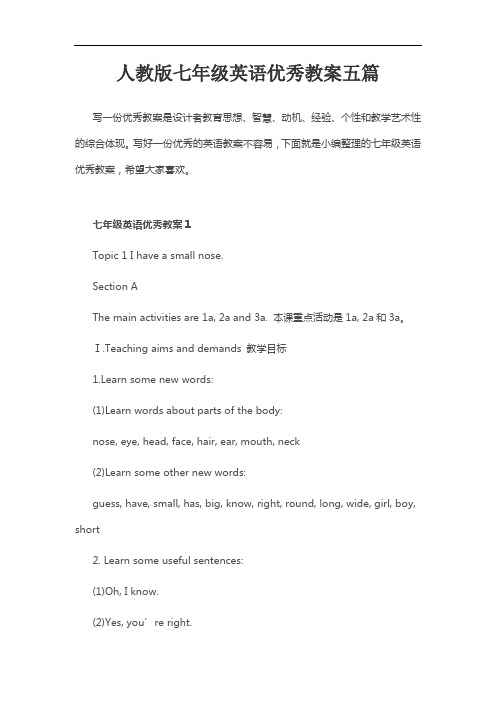
人教版七年级英语优秀教案五篇写一份优秀教案是设计者教育思想、智慧、动机、经验、个性和教学艺术性的综合体现。
写好一份优秀的英语教案不容易,下面就是小编整理的七年级英语优秀教案,希望大家喜欢。
七年级英语优秀教案1Topic 1 I have a small nose.Section AThe main activities are 1a, 2a and 3a. 本课重点活动是1a, 2a和3a。
Ⅰ.Teaching aims and demands 教学目标1.Learn some new words:(1)Learn words about parts of the body:nose, eye, head, face, hair, ear, mouth, neck(2)Learn some other new words:guess, have, small, has, big, know, right, round, long, wide, girl, boy, short2. Learn some useful sentences:(1)Oh, I know.(2)Yes, you’re right.3. Learn the simple present tense with“have/has”and adjectives of description:(1)I have a big nose.(2)They have round faces.(3)She has long hair.(4)It has big ears.4. Learn how to describe people’s appearances.Ⅱ. Teaching aids 教具小黑板/影片的封面或图片/教学挂图/录音机Ⅲ. Five-finger Teaching Plan 五指教学方案Step 1 Review 第一步复习(时间:10分钟)通过复习,培养学生根据图画和文字信息进行简单交流的能力。
七年级英语音标教案5篇

七年级英语音标教案5篇Unit1SectionA(GrammarFocu-3c)一、教学目标:1.语言知识目标:1)继续练习运用情态动词can。
学会询问和谈论彼此的能力和特长。
①—Canyouplaytheguitar—Ye,Ican./No,Ican't.②—Whatcanyoudo—Icandance.③—Whatclubdoyouwanttojoin—2.情感态度价值观目标:对自身的认识,为将来的自我发展奠定基础。
二、教学重难点1.教学重点:1)让学生重点总结、发现情态动词can2)2.教学难点:1)情态动词can的用法;2)在实际交际活动中运用来询问与表达自己或他人的能力。
三、教学过程Ⅰ.Warming-upandreviionT:Hi,S1!WhatcanyoudoS1:Icaninganddance2.Role-play.Ⅱ1.2.中的句子,然后做填空练习。
①②/不,我不会。
Ye,___________./No,I_______.…(其余试题见课件部分)3.学生们完成填空试题后,可以打开课本检查答案,对错误的句子,单独进行强化记忆。
Ⅲ.TrytoFind老师将情态动词的can的用法,以学案的方式呈现在大屏幕上,让学生自主学习,并发现其用法。
1.可以看出,在Can…句型中,情态动词can没有________和_______的变化。
2.用情态动词can来询问他人的能力可以归纳为以下句型:Can+_______+_________+其他肯定回答:_________________否定回答:_________________What+can+_______+________学生们合作学习讨论上面学案的答案,总结情态动词can的用法。
老师找部分学生对上述问题作答,并一起讨论总结情态动词can的用法。
Ⅳ.Practice1.Lookat3a.告诉学生们用所给的词汇来造句子。
首先,用情态动词can及所给的第一个动词词组来造一个一般疑问句,并作出一个否定的回答。
七年级英语优秀教案多篇2021

七年级英语优秀教案多篇2021七年级英语优秀教案1Starter Unit2 what’s this in English? 第1课时section1a-2e 【学习目标】语言目标:字母I—R;辨认物品;拼写单词1.七个表示物体的单词的熟练掌握。
(汉语意思写出来) map orange jacket key quilt pen ruler 确认物体的句型(写出意思):问:What is this in English? 答:It's /a /an/ map/ orange/ jacket/ key/ pen/ ruler/ quilt.3.区分a和an的用法(读书上87页:冠词用法)。
【预习指导】自我预习一、扫清障碍试着用按英语中音标拼读出StarterUnit21a的单词(在书上第94页)。
二、课本预习温故知新1.按照字母顺序正确默写上单元学过的八个字母的大小写。
2.小组合作用英语完成对话。
1)熟识朋友见面的问候语和应答。
——Hello, Frank! ——Hi, Cindy! How are you? ——I'm fine / OK, thanks.2)一天见面打招呼的用语。
__Good morning, Helen!__,Bob! __Good , Eric!__Good afternoon, Grace! __Good evening, Helen!__,Dale!:__Hi, Alice!__Hi, Cindy! __Hello,Frank!__Hello, Dale! 【课内学习】一、教材处理:自主互助学习1.看图认一认1a中认识的字母,并把它写下来。
小组讨论答案,教师巡回检查。
2.看图认物品,努力用英语说出认识的物品,小组比一比,哪一个小组认识的物品多。
二、组内探讨1)看图片或者用实物小组做对话练习。
师生备注2)听1a录音,指出听到的物品。
3)用图中物品,双人自由问答并表演。
人教版七年级上册英语教案16篇

人教版七年级上册英语教案16篇人教版七年级上册英语教案(精选篇1)一、复习指导思想新授课结束后,期末考试前,指导学生进行期末复习,主要复习基础知识,提高做题能力,训练阅读、听力与写作,使学生能够举一反三,熟练掌握知识点与考点.二、学生学习水平现状分析学生的主要问题是基础薄弱,做题能力参差不齐,优秀的学生不多,成绩有待于提高的学生比较多,一部分同学学习惰性强。
三、复习时间:十七周至十八周(共10课时)四、复习重点1、基础知识:unit1—unit8:重点词汇、短语、句型2、语法:(1)动词不定式(2)动名词(3)被动语态(4)形容词相关句型的运用(5)副词的运用(6)原因状语从句(7)过去进行时3、阅读训练(报纸阅读材料)4、听力(报纸、导学案套题听力训练)5、话题写作:肢体语言,义务工作,传统技艺,卡通漫画、动物保护、动物描写、未来生活畅想6、复习中注重讲练结合,及时反馈,及时检测五、课时安排时间为两周,具体计划如下:十七周(周一)unit1、2重点词组句型小结;语法训练(报纸2、3版)十七周(周二)unit1、2知识点练习,话题写作训练(报纸4版)十七周(周三)unit3、4重点词组句型小结;语法训练(报纸5、6版)十七周(周四)unit3、4知识点练习,话题写作训练(报纸7版)十七周(周五)unit5、6重点词组句型小结;语法训练(报纸8、9版)十八周(周一)unit5、6知识点练习,话题写作训练(报纸10版)十八周(周二)unit7、8重点词组句型小结;语法训练(报纸11、12版)十八周(周三) unit7、8知识点练习,话题写作训练(报纸13版)十八周(周四)模拟套题(报纸31版)(综合测试一)十八周(周五)模拟套题(报纸32版)(综合测试二)六、复习措施1、单词过关。
每天重点句子听写2、语法复习注重讲练结合,引导学生说出重点与易错点3、加强整理英语学习档案4、对于阅读训练有指导,有检测。
人教版英语七年级教案5篇

人教版英语七年级教案5篇人教版英语七年级教案1教学目标Teaching aims (教学目标)1. 学习祈使句的否定形式。
2. 学会使用祈使句表示规则。
3. 能够熟练使用can和can’t表示许可。
4. 能和同学谈论校规。
教学重难点Language points (语言点)1. 词汇:1)名词n. rule, hallway, hall, fight2) 动词v. arrive, listen, fight, wear3) 形容词 adj. sorry, outside4) 词组 be on time, dining hall, listen to…2. 句型:What are the rules? We can’t …./Don’t …/We have to …Can we … ? Yes, we can./No, we can’t.What do you have to do? We have to …Difficulties (教学难点)1.祈使句的否定形式。
2. 如何谈论规则。
教学过程Teaching steps (教学步骤)1. Warm-up and revision(课堂热身和复习)(1)Greet the class.(2) Listen to a song.T: Do you like this beautiful song?Can we listen to it in class?T: Can we listen to music in the classroom?What can we do in the classroom?What can’t we do in the classroom?【教学设计说明】通过听歌曲来导入本单元的主要话题——规则。
让学生自由谈论在教室里可以做的事情和不可以做的事情,帮助学生培养秩序感。
2. Presentation (呈现新知识)(1) Present the new words: classroom, hallway, dining room, fight, arriv e late for class.Show some pictures of the new words on the screen. Have Ss read these words.classroom, hallway, dining room, fight, arrive late for class(2) Flash some pictures quickly on the screen. Have Ss say the words according the pictures as quickly as they can.(3) Show some pictures of different activities that are happening in the school.Help Ss understand the school rules.T: Can you run in the hallways? Don’t run in the hall ways.T: Can you fight? Don’t fight.T: Can you listen to music in class? Don’t listen to music in class.T: Can you eat in the classroom? Don’t eat in the classroom.You can only eat in the dining hall.T: Can you arrive late for class? Don’t arrive late for class.You must be on time.【教学设计说明】图片教学法是呈现新知识最简单有效的方法之一,学生通过图片,能更价值观的理解新单词的含义。
初中英语教学设计【优秀14篇】
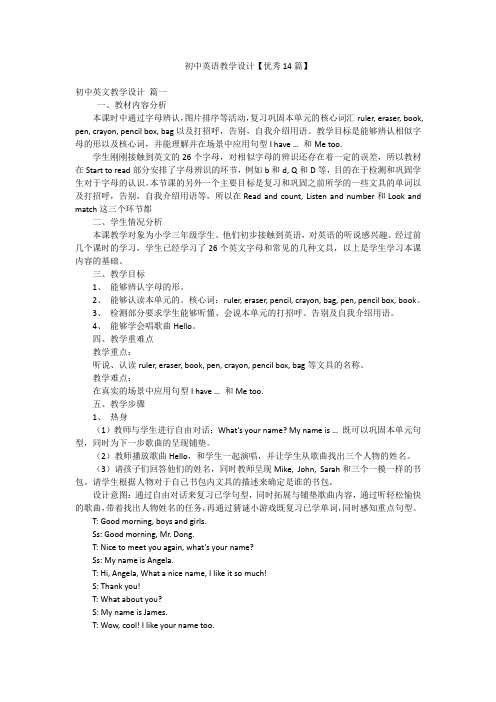
初中英语教学设计【优秀14篇】初中英文教学设计篇一一、教材内容分析本课时中通过字母辨认,图片排序等活动,复习巩固本单元的核心词汇ruler, eraser, book, pen, crayon, pencil box, bag以及打招呼,告别,自我介绍用语。
教学目标是能够辨认相似字母的形以及核心词,并能理解并在场景中应用句型I have … 和Me too.学生刚刚接触到英文的26个字母,对相似字母的辨识还存在着一定的误差,所以教材在Start to read部分安排了字母辨识的环节,例如b和d, Q和D等,目的在于检测和巩固学生对于字母的认识。
本节课的另外一个主要目标是复习和巩固之前所学的一些文具的单词以及打招呼,告别,自我介绍用语等,所以在Read and count, Listen and number和Look and match这三个环节都二、学生情况分析本课教学对象为小学三年级学生。
他们初步接触到英语,对英语的听说感兴趣。
经过前几个课时的学习,学生已经学习了26个英文字母和常见的几种文具,以上是学生学习本课内容的基础。
三、教学目标1、能够辨认字母的形。
2、能够认读本单元的。
核心词:ruler, eraser, pencil, crayon, bag, pen, pencil box, book。
3、检测部分要求学生能够听懂、会说本单元的打招呼、告别及自我介绍用语。
4、能够学会唱歌曲Hello。
四、教学重难点教学重点:听说、认读ruler, eraser, book, pen, crayon, pencil box, bag等文具的名称。
教学难点:在真实的场景中应用句型I have … 和Me too.五、教学步骤1、热身(1)教师与学生进行自由对话:What’s your name? My name is … 既可以巩固本单元句型,同时为下一步歌曲的呈现铺垫。
(2)教师播放歌曲Hello,和学生一起演唱,并让学生从歌曲找出三个人物的姓名。
新课标七年级上册英语教案全册(最新7篇)
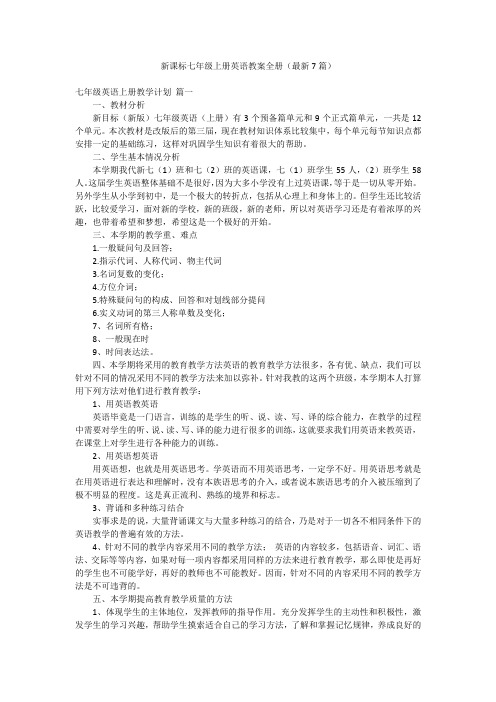
新课标七年级上册英语教案全册(最新7篇)七年级英语上册教学计划篇一一、教材分析新目标(新版)七年级英语(上册)有3个预备篇单元和9个正式篇单元,一共是12个单元。
本次教材是改版后的第三届,现在教材知识体系比较集中,每个单元每节知识点都安排一定的基础练习,这样对巩固学生知识有着很大的帮助。
二、学生基本情况分析本学期我代新七(1)班和七(2)班的英语课,七(1)班学生55人,(2)班学生58人。
这届学生英语整体基础不是很好,因为大多小学没有上过英语课,等于是一切从零开始。
另外学生从小学到初中,是一个极大的转折点,包括从心理上和身体上的。
但学生还比较活跃,比较爱学习,面对新的学校,新的班级,新的老师,所以对英语学习还是有着浓厚的兴趣,也带着希望和梦想,希望这是一个极好的开始。
三、本学期的教学重、难点1.一般疑问句及回答;2.指示代词、人称代词、物主代词3.名词复数的变化;4.方位介词;5.特殊疑问句的构成、回答和对划线部分提问6.实义动词的第三人称单数及变化;7、名词所有格;8、一般现在时9、时间表达法。
四、本学期将采用的教育教学方法英语的教育教学方法很多,各有优、缺点,我们可以针对不同的情况采用不同的教学方法来加以弥补。
针对我教的这两个班级,本学期本人打算用下列方法对他们进行教育教学:1、用英语教英语英语毕竟是一门语言,训练的是学生的听、说、读、写、译的综合能力,在教学的过程中需要对学生的听、说、读、写、译的能力进行很多的训练,这就要求我们用英语来教英语,在课堂上对学生进行各种能力的训练。
2、用英语想英语用英语想,也就是用英语思考。
学英语而不用英语思考,一定学不好。
用英语思考就是在用英语进行表达和理解时,没有本族语思考的介入,或者说本族语思考的介入被压缩到了极不明显的程度。
这是真正流利、熟练的境界和标志。
3、背诵和多种练习结合实事求是的说,大量背诵课文与大量多种练习的结合,乃是对于一切各不相同条件下的英语教学的普遍有效的方法。
最新七年级上册英语教案人教版免费(8篇)

最新七年级上册英语教案人教版免费(8篇)七年级上册英语教案人教版免费【篇1】Unit 1 Topic 3 How old are you ?Section D学习目标1.学习以短文形式谈论姓名、年龄、学校、班级和电话号码等个人信息2.能读懂短文并能从简单的名片中获得信息3.能向大家做自我介绍学习重点以短文形式谈论姓名、年龄、学校、班级和电话号码学习难点第一人称和第三人称的转变学习过程(一)导入(二)自学指导1、预习课本P23 Part 1 ,复习书上的六个音标2、预习课本P23 Part 2 ,分别找出Jane 和 Huang Hua 的个人信息3、预习P23 Part 3 ,根据所给信息把空补充完整4、背诵课本P24 Part 4a 4b(三)问题导学再看课本P22 Part 2 ,回答问题。
Where is Jane from ?__________________________How old is she ?___________________________What class is she in ? _____________________Where is Huang Hua from ? _______________What’s his English name ? _____________________Are they in the same class ? ______________(四)典题训练(五)精讲点拨1、They are not in the same class ,but they good friends.他们不在同一个班,但是他们是好朋友。
解析:same 意思是“相同的”,前面一定要用定冠词“the”,后面接单数名词。
but 意为“但是,可是”,起转折作用。
eg : We are in the same school ,but in different classes . 我们在同一个学校,但是在不同的班级。
七年级英语主题教案七篇

七年级英语主题教案七篇七年级英语主题教案七篇从8世纪到12世纪,古英语通过语言接触逐渐转变为中古英语。
中古英语往往是随意定义为开始英格兰的征服由法国诺曼公爵征服者威廉在1067年,但它从1210-1550期间进一步发展。
下面是小编为大家带来的七年级英语主题教案七篇,希望大家能够喜欢!七年级英语主题教案精选篇1一、语言知识与技能1.根据读音规则和音标拼读单词。
2.理解和领悟词语的基本含义、语法项目以及语言形式的基本结构和常用表意功能;3.能在日常交际情景中听懂对话,例如,能听懂连续的指令并据此完成任务;能引出话题并进行几个回合的交谈;4.能听懂接近正常语速、熟悉话题的语段和简单故事,获取相关信息;5.能运用…..词汇和…..语言形式就熟悉的话题进行交谈;能运用…..词汇和…..语言形式及(或)所给提示描述人、物、事件、行为、特征等,表达简单的观点;6.能在教师的指导下进行简单的角色表演;7.能连贯、流畅地朗读课文;能从简单的故事和短文中找出有关信息,抓住大意;根据上下文猜测生词的意思;8.每天课外阅读量最少达到200词。
9.能运用…..词汇和…..语言形式以及参照范例(文章结构)写出简单的文段等,包括起草和修改。
二、文化意识10.了解语言和语用的文化因素,体验跨文化交际。
三、学习策略11-(1)利用读音规则和音标拼读词汇,利用上下文、非语言信息等理解词义,联想学习和记忆词汇,构词法等。
11-(2)利用情境等理解语法结构和表意功能,发现语言规律并举一反三。
11-(3)复习、整理归纳所学内容。
11-(4)利用预测、语调、重音、问题等来获取听力信息。
11-(5)在课内外活动中借助体态语用英语交流。
11-(6)利用预测、跳读、寻读、细节读等来获取文章信息。
11-(7)仿写短文,准备素材、起草短文并修改。
11-(8)明确目标,制定计划,11-(9)了解并跨文化交际(恰当使用)。
四、情感态度12.乐于参与英语活动,敢于用英语表达,积极与他人合作,体验自己的学习效果。
- 1、下载文档前请自行甄别文档内容的完整性,平台不提供额外的编辑、内容补充、找答案等附加服务。
- 2、"仅部分预览"的文档,不可在线预览部分如存在完整性等问题,可反馈申请退款(可完整预览的文档不适用该条件!)。
- 3、如文档侵犯您的权益,请联系客服反馈,我们会尽快为您处理(人工客服工作时间:9:00-18:30)。
1.Show a picture and ask, "Can they play football there Please listen to the recording and answer my question." Let the
Listen and answer.
Ss act the dialogue and then make up their own dialogues.
Finish the homework.
The usage of bring and take is a point but an difficult point in this lesson.
教学过程
教学环节
教师活动
学生活动
备课札记
Step1 Greetings
Step2 Revision
Step3 Presentation
Step4 Practice
Step5 Listening
Step6 Assignment
Good morning, class!
How are you today?
1. Preview the new words.
2. Do Wb Ex.1 before class.
教学过程
教学环节
教师活动
学生活动
备课札记
Step1
Revision
Step2 Presentation
Step3 Practice
Step4
Consolidation
Step5 Assignment
2. Listen to the tape..
教学过程
教学环节
教师活动
学生活动
备课札记
Step1 Revision
Step2
Presentation
Step4 Discussion
Step5 Listening and answering
Step6 Practice
Step7
Grammar
Step8
能力目标
LearnGreat! We can… We can’t… I see
情感目标
Train the Ss to have social moralities.
教学重点
Sentence patterns:We can… We can’t…
教学难点
1.动词bring的用法2.can的否定形式
课前预习
means we can…/wecan’t…”
Listen and retell.
Finish the homework
达标情况
七年级英语教案
总课题
Unit 9 Signs (Starter)
总课时
5
第3课时
课题
Speaking and Grammar
课型
新授课
教学目标
知识目标
1.Vocabulary:eat, homework, write, shout, newspaper, internet
.Show a football to the students and say, "This is a football." Point to the playground and say, "We can play football there. But we can't play football here." Tell the Ss Don’t play on the roador in the street.
1.Ask the students to take out the signs prepared to say something about them. e.g.Look at the signs. Wecanplay football on the playground, but wecan’tplay it in the classroom. Wecanwalk in the park, but wecan’tclimb the hill. Wecanwatch the animals, but wecan’tfeed them. etc.
1.Copy the phrases and make sentences with them.
2.Make a dialogue with the neighbor.
Appendix: The Bb design
What can I do?
watch TV Listen to music
fly kites ride a bike smoke
2.Have a free talk with the students. Revise something learned, e.g.
T: What can you do in the classroom?
Ss: We can listen to music, read books.
T: What can’t you do in the classroom?
students listen it again and read after the recording.
2.Get the students to act the dialogue out in groups of three or four. Encourage them to act out with the objects for performance.
教学重点
New Words: eat, homework, write, shout, newspaper, internet
教学难点
.The usage of can in theCan I…? Yes, you can. No, you can’t.
课前预习
1. Preview the new words.
home. Then give some time phrases “after school, in the evening, at night, at lunch” and have similar exercises, e.g. We can fly a kite after school.
We can’t play games at night.
Why not?Let’s(=Let us) go.
I see.
Ss listen to the teacher and answer the teacher’s questions.
Ss look at the pictures,
Listen to the teacher, learn the new words.
Consolidation by
speaking.
Talk with the
teacher freely.
Look, listen and
learn.
The students open the books and ask them some questions about the pictures
Then answer “It
七年级英语教案
总课题
Unit 9 Signs (Starter)
总课时
5
第1课时
课题
Welcome(Don’t play in the street.)
课型
新授课
教学目标
知识目标
Enable the students to master some new words: can, play, football, us, why, bring, oh, sign
Assignment
1.Check the homework.
2.Play a game (Look, act and say)
We can watch TV at home, but we
can’t watch TV in the playground.
We can fly a kite after school.
We can’t play games at night.
Greet with the
teacher freely!
Present “listen to music, fly a kite, play games, ride a bike, smoke” in the same way.
.Show some place phrases “in the play-ground, at home, at school, in class” etc. Get the students to make sentences with “can, can’t” and these phrases. e.g. We can’t listen to music in class, but we can listen to music at
Make some sentences about them.
Appendix:The Bb design
Don’t play in the street.
Look at the sign!
Wecanplay football there.
Wecan’t(=can not) play football here.
Have a free talk with the students. Revise something learned in Unit 8
Show some signs and say to the students, " Look at the signs! We can
